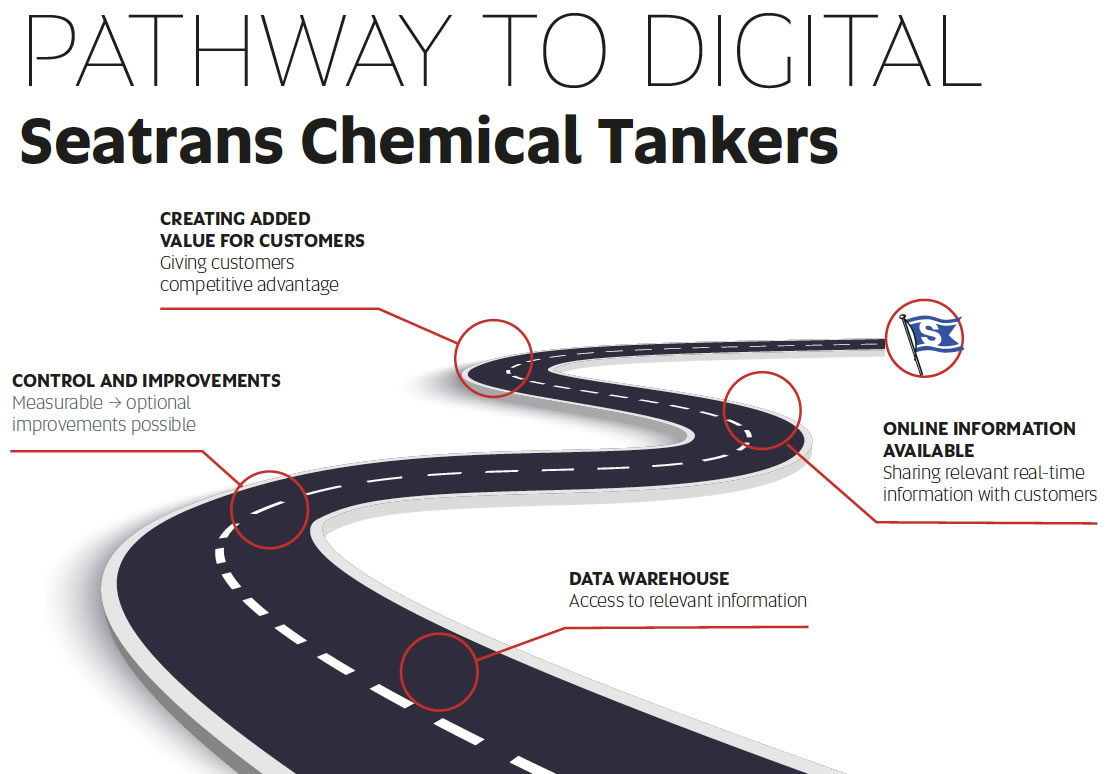”We collect a huge amount of digital information from a number of sources on shore and at sea. So far, we have used the input we’ve got for specific purposes. During the next stage, we will look at how we can combine valuable information from operations at sea, at berth and on shore in order to improve our performance. And not least, we will provide our clients with valuable information that completes their own knowledge-base related to their value chain.”
Managing Director Tom Skare in Seatrans Chemical Tankers (SCT) and his team have set a new agenda for the company.
“In recent years, the chemical tanker shipping industry has been exposed to overcapacity in the market, increased competition and shrinking margins. SCT can neither influence the global tonnage surplus nor the fact that the market has favoured the clients. However, Seatrans can improve its services and help our clients to improve their value chain and profitability. That is what the new digital concept is all about,” Tom Skare explains.
Business development
“There is no other alternative besides reducing costs and improving time consuming processes. Actually, we really have improved the time we spend on a number of our critical processes and operations. Saying ‘we are the best’ is not our style, but a benchmarking process we carried out convinces us that we are among the best in the class. We have very few accidents, our cost base is good, the standard on our vessels is very high, and best of all: we have super motivated and skilled seafarers who deliver high quality shipping operations. All in all, we are a very strong team on shore and at sea combined. However, our competitors are also clever; we cannot rest and rely on what we achieved yesterday.
We also notice that operations at the terminals are getting more complex, more regulations have emerged, and more are in the time spent at the port is increasing. In order to be more efficient, we have to put more data together, following the logistic chain together with our clients and see how we can reduce valuable time and resources for both parties. We have to be careful when we select and prioritise projects that can give us significantly better results.”
Real time
The shipping industry has been a somewhat slow mover when it comes to taking the new digital revolution to heart. More or less all on shore industries have started their search for excellence using “big data” from their business processes. The shipping industry is now following suit at full speed. This opens the door to new options in the client-provider relationship. “Our clients want us to be more transparent and share valuable information with them in real time. We certainly accept that the goods belong to our clients while on our vessel.
These are valuable liquids that our clients want to follow. Think of the tracing options you have when you order anything in a virtual store on the Internet. You can follow your item all the way to your address at home. Why shouldn’t our clients have the same opportunity? What we see is an increased interest in a seamless information flow between our clients and us. We have a common interest in reducing the time we use from A to B, and we are convinced that by increased digitalisation and improved flow of critical information, with a common effort both will enjoy better profits and competitiveness in the coming years.”
Step by step
“Our approach can be explained by walking upstairs compared to climbing a steep wall with a rope. We use a Microsoft software platform with application in the virtual cloud. This eases accessibility for both internal and external users and it eliminates problems with updates and new software upgrades. We emphasise the ability to exchange data across background systems. The critical evaluation point is that our clients can open the solution, so they may get the information that is relevant for them,” says BI Developer Ådne Brunborg in SCT. “Our ambition is to (even) reduce errors, optimise operations and ease the information flow. In order to achieve all this, we need to ’robotise’ both information collection and processing of the most common operations. We also need to tailor-make some reports to be generated automatically. Thirdly, we need to identify more of the points in our operations and processes where we can do better than we do today.”
Digitalisation is a tool, not a goal. Both Tom Skare and Ådne Brunborg are aware of that. “This is business development in a new, digital age. From here, we only see the beginnings of a long and positive process!”


